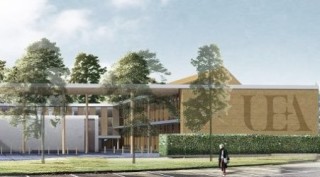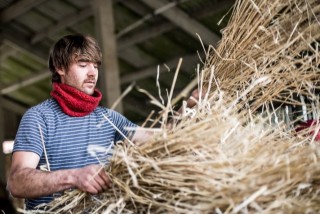The University of East Anglia’s new Enterprise Centre, currently under construction, is expected to be one of the greenest buildings in the country. And a key ingredient is the thatched cassettes that clad the building.
The cassette cladding is a completely new way of using thatch, according to main contractor Morgan Sindall. It is one of the key sustainable elements being incorporated into the £11.6m construction project, developed by the Adapt Low Carbon Group.
Combining traditional craft with modern methods of construction, it is the first time this thatch cassette cladding system has ever been used. It is anticipated that the technique, which claims various economic, environmental and safety benefits, could be replicated on future construction projects, perhaps paving the way for thatch to return to its former position as a mainstream construction material.
The pioneering concept of thatch cassettes was conceived by Morgan Sindall and its design team with project architect Architype. The process involves fabricating a set of timber cassette modules that are filled with straw in local thatchers’ barns across Norfolk. The prefabricated thatch cassette panels are then transported to site and erected onto the façade of the building as a rainscreen cladding.
The cassettes have been constructed by local joiner Fox Joinery and thatched in straw from the Norfolk Suffolk borders by a skilled team led by the master thatcher of East Anglia, Stephen Letch.
The University of East Anglia’s Enterprise Centre (pictured below) is on course to achieve BREEAM Outstanding and Passivhaus certification. It will also have one of the lowest embodied carbon footprints of any building of its size in the UK, it is claimed.
John French, project director and CEO of the Adapt Low Carbon Group, said: “Standing at the gateway to the UEA, The Enterprise Centre will make a striking statement about the university’s commitment to the environment and continue its legacy of pioneering architecture. The building will look totally unique, and for local businesses and start-ups which take up tenancy in the building, it will be a unique place to work and grow their businesses.”

Morgan Sindall senior design manager Stuart Thompson said: “Sourcing local materials and connecting with local suppliers, craftsmen and tradespeople were key commitments on this project. The straw that has been used for the thatch was sourced less than 20 miles from the site and our delivery team uses the skills of a group of local thatchers.
“Thatching is a traditional craft, which is generally in decline, but we have already seen evidence that by using thatch in this innovative way on this project, the trade is generating a renewed interest that will help to reinvigorate this industry locally, and in time, nationally.”
He added: “Thatch is a carbon-negative material, it’s also highly insulative and offers exceptional rainscreen protection – so it is a great material to use as cladding. The use of cassettes to place the thatch on the walls as cladding is a unique approach and a great example of the creativity and originality which the project team has brought to this project.”
Architect Ben Humphries, associate director of Architype, said: “'The development of the thatch cassettes has been a truly collaborative process between Architype, Morgan Sindall, Stephen Letch and the thatchers. A number of design workshops enabled the team to collectively refine initial concepts into buildable solutions, and then a series of 1:1 prototypes were developed to refine the product. We are delighted with the result; an ultra-low carbon, locally sourced and beautiful cladding, which will give the building a unique and iconic appearance.”
One of the innovative elements of the process involves the cassettes being thatched in a workshop off-site and then brought onto site and installed like normal cladding. The thatchers are able to work indoors, negating the need for the work to be done in-situ, avoiding the risks associated with working at height and removing the reliance on good weather to enable work to take place, as well as opening up the winter season to thatching work. Around 294 cassettes will be installed onto the building over the coming months, covering 1,200 square metres.
Got a story? Email news@theconstructionindex.co.uk




